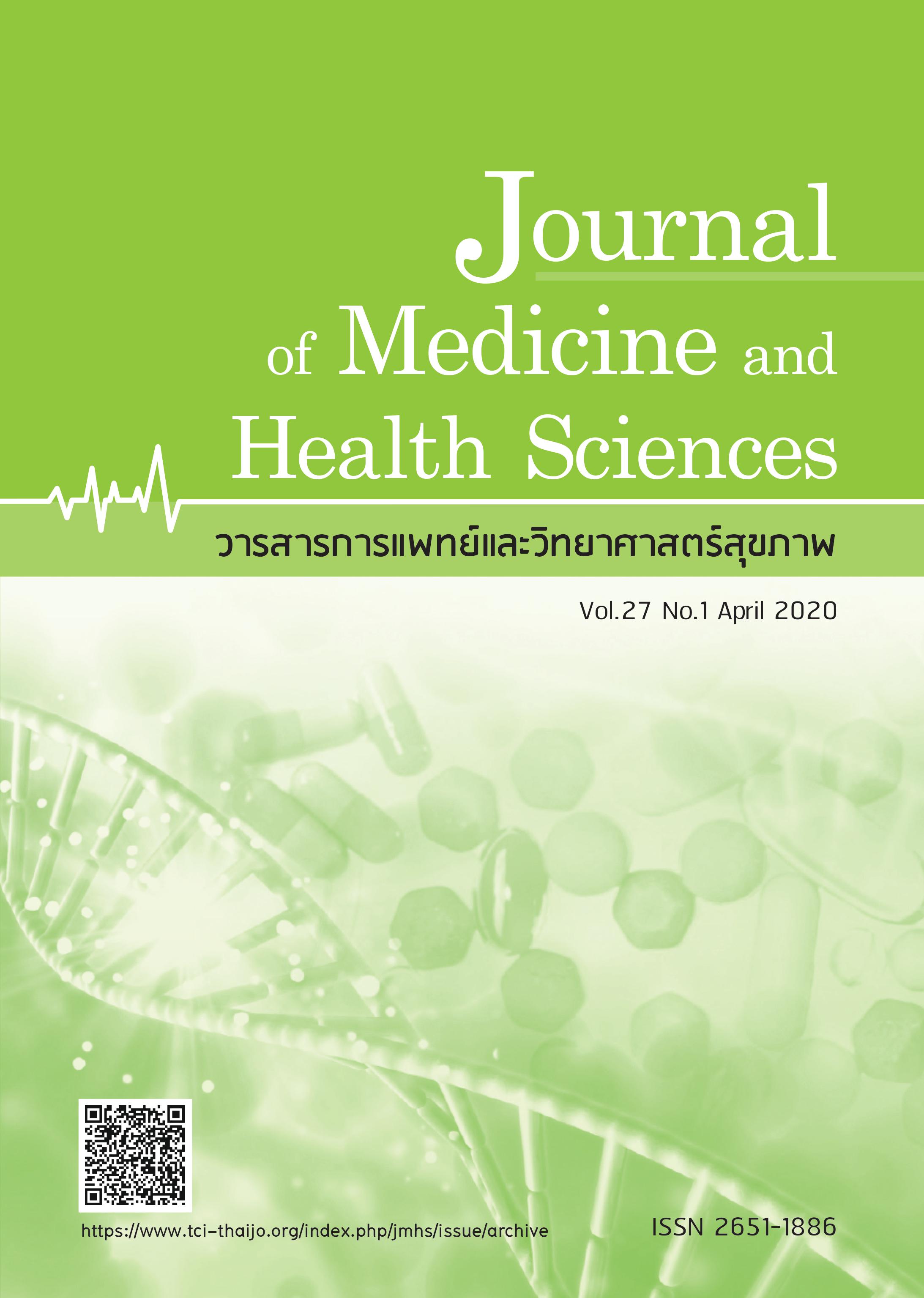Acute effect of dynamic stretching on running endurance and EMG activity in long-distance runner
Keywords:
stretching, long-distance running, total running distance, time to exhaustion, electromyographyAbstract
บทคัดย่อ
การวิจัยนี้มีวัตถุประสงค์เพื่อศึกษาผลฉับพลันของการยืดกล้ามเนื้อแบบพลวัตร ต่อระยะทางทั้งหมดในการวิ่ง ระยะเวลาในการล้าขณะวิ่ง และการทำงานของคลื่นไฟฟ้ากล้ามเนื้อ ในนักวิ่งระยะไกลเพศชายกลุ่มตัวอย่างเป็นนักวิ่งระยะไกลอายุ 18-30 ปี มีประสบการณ์ในการวิ่งไม่น้อยกว่า 1 ปี และต้องมีระยะทางสะสมไม่น้อยกว่า 3,000 กิโลเมตร หรือเฉลี่ย 3 ครั้งต่อสัปดาห์ (150 นาทีต่อสัปดาห์) จำนวนผู้เข้าร่วมวิจัย 15 คน ผู้เข้าร่วมวิจัยทั้งหมดจะต้องทำการทดลองทั้งแบบไม่ยืดกล้ามเนื้อ และยืดกล้ามเนื้อแบบพลวัตรก่อนวิ่ง โดยวิธีการสุ่ม เวลาทั้งหมดที่ใช้ในการยืดกล้ามเนื้อแบบพลวัตร คือ 10 นาที จังหวะความเร็วที่ใช้ในการ ยืดกล้ามเนื้อแบบพลวัตรในแต่ละกล้ามเนื้ออยู่ที่ 100 ครั้ง/นาที และทำการยืดกล้ามเนื้อไปจนถึงช่วงที่เริ่มมีความรู้สึกตึง ทำการวัดคลื่นไฟฟ้ากล้ามเนื้อ (EMG) ของกล้ามเนื้อ 6 มัด (gluteus maximus,semitendinosus, gastrocnemius medialis, rectus femoris, tibialis anterior, and soleus) ปริมาณการใช้ออกซิเจน และ EMG จะทำการวัดก่อนและระหว่างการวิ่งบนลู่วิ่ง ไฟฟ้าจนกระทั่งหมดแรง เพื่อเปรียบเทียบความแตกต่างของระยะทางทั้งหมดในการวิ่ง ระยะเวลาในการล้าขณะวิ่ง และคลื่นไฟฟ้ากล้ามเนื้อ วิเคราะห์ข้อมูลทางสถิติด้วย Two way repeated measured ANOVA ผลการศึกษาพบว่า การยืดกล้ามเนื้อแบบพลวัตรมีระยะทางทั้งหมดในการวิ่ง และระยะเวลาในการล้าขณะวิ่ง มากกว่าแบบที่ไม่มีการยืดกล้ามเนื้อ อย่างมีนัยสำคัญทางสถิติ (p<0.05) การทำงานของคลื่นไฟฟ้ากล้ามเนื้อไม่มีความแตกต่างกันอย่างมีนัยสำคัญ ทั้งสองกลุ่ม จึงสรุปได้ว่าในการศึกษาครั้งนี้ นักวิ่งระยะไกลเพศชายที่มีการยืดกล้ามเนื้อแบบพลวัตร สามารถ เพิ่มระยะทางทั้งหมดในการวิ่ง และระยะเวลาในการล้าขณะวิ่งได้ดีกว่าแบบที่ไม่มีการยืดกล้ามเนื้อ และสามารถนำผลการวิจัยไปประยุกต์ใช้ในการสร้างโปรแกรมการยืดเหยียดกล้ามเนื้อแบบพลวัตรก่อนการวิ่งระยะไกลได
Abstract
The purpose of this study was to investigate the acute effect of dynamic stretching,total running distance, time to exhaustion, and EMG activity in male long-distance runners. Fifteen male long-distance runner whose aged 18 to 30 years old participated in this study. They have experienced for running at least 1 year and running mileage at least 3,000 km, or average running 3 times per week (150 minute per week). This study was a randomized crossover design, participants were randomly done the dynamic stretching and non-stretching. The total duration of dynamic stretching intervention was 10 min with velocity 100 beats/min in each muscle and stretched until the point of starting discomfort. Electromyography (EMG) was placed on 6 muscles (gluteus maximus, semitendinosus, gastrocnemius medialis, rectus femoris, tibialis anterior, and soleus). Oxygen consumption and EMG were measured before and during running on a treadmill until exhausted in order to compare total running distance, time to exhaustion and muscle activity. Two way repeated measured ANOVA was used to compare between dynamic stretching and non-stretching. The results showed that time to exhaustion and total running distance of dynamic stretching were significantly increased more than those of the non-stretching (p<0.05). EMG activity was not significance difference between groups in conclusion, the present study demonstrated that dynamic stretching done before exercise would enhance the time to exhaustion and total running distance in male long-distance runner. In addition, this research can applied for dynamic stretching purpose before long-distance running.
References
2. Behm DG, Blazevich AJ, Kay AD, et al. Acute effects of muscle stretching on physical performance, range of motion, and injury incidence in healthy active individuals: a systematic review. Appl Physiol Nutr Metab 2015;41(1):1-11.
3. Behm DG, Chaouachi A. A review of the acute effects of static and dynamic stretching on performance. Eur J Appl Physiol 2011;111(11):2633-51.
4. Herda TJ, Cramer JT, Ryan ED, et al. Acute effects of static versus dynamic stretching on isometric peak torque, electromyography, and mechanomyography of the biceps
femoris muscle. J Strength Cond Res 2008;22(3):809-17.
5. Hayes PR, Walker A. Pre-exercise stretching does not impact upon running economy. J Strength Cond Res 2007;21(4):1227.
6. Hough PA, Ross EZ, Howatson G. Effects of dynamic and static stretching on vertical jump performance and electromyographic activity. J Strength Cond Res 2009;23(2):507-12.
7. Pearce AJ, Kidgell DJ, Zois J, et al. Effects of secondary warm up following stretching. Eur J Appl Physiol 2009;105(2):175-83.
8. Jaggers JR, Swank AM, Frost KL, et al. The acute effects of dynamic and ballistic stretching on vertical jump height, force, and power. J Strength Cond Res 2008;22(6):1844-9.
9. Papadopoulos G, Siatras T, Kellis S. The effect of static and dynamic stretching exercises on the maximal isokinetic strength of the knee extensors and flexors.Isokinet Exerc Sci 2005;13(4):285-91.
10. Who EC. Appropriate body-mass index for Asian populations and its implications for policy and intervention strategies. Lancet 2004;363(9403):157.
11. Thompson PD, Arena R, Riebe D, et al. ACSM’s new preparticipation health screening recommendations from ACSM’s guidelines for exercise testing and prescription. Curr Sports Med Rep 2013;12(4):215-7.
12. Bruce RA, Kusumi F, Hosmer D. Maximal oxygen intake and nomographic assessment of functional aerobic impairment in cardiovascular disease. Am Heart J 1973;85(4):546-62.
13. Yamaguchi T, Takizawa K, Shibata K.Acute effect of dynamic stretching on endurance running performance in welltrained male runners. J Strength Cond Res 2015;29(11):3045-52
14. Gelen E. Acute effects of different warm-up methods on sprint, slalom dribbling, and penalty kick performance in soccer players. J Strength Cond Res 2010;24(4):950-6.
15. Tsuji K, Ishida H, Oba K, et al. Activity of lower limb muscles during treadmill running at different velocities. J Phys Ther Sci 2015;27(2):353-6.



